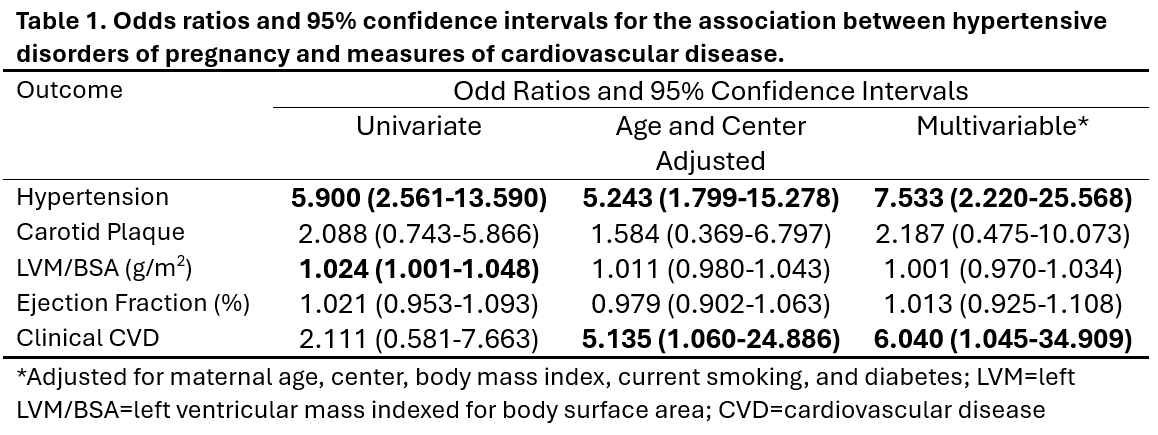Final ID: P2142
Hypertensive disorders of pregnancy (HDP) and cardiovascular disease (CVD) in American Indians: The Strong Heart Family Study (SHFS)
Abstract Body: Introduction: American Indian populations have high risks of both hypertensive disorders of pregnancy (HDP) and cardiovascular disease (CVD) yet few studies have evaluated associations of HDP and CVD in these populations.
Aim: To determine if the odds of hypertension outside of pregnancy (HTN), carotid artery plaque, left ventricular mass indexed to body surface area (LVM/BSA), ejection fraction (EF), or clinical CVD events are higher in HDP cases compared to controls from the SHFS.
Methods: We included 66 cases of HDP (preeclampsia and gestational hypertension) confirmed by medical records and/or birth certificates, matched on date of delivery (±3 years) to 185 controls. We defined HTN as systolic blood pressure (BP) ≥140 mm HG, diastolic BP ≥ 90 mmHg, or taking HTN medication. We used ultrasounds to measure carotid artery plaque, echocardiograms to measure LVM/BSA and EF, and physician adjudication to determine CVD events. We used conditional logistic regression to determine if the odds of HTN, plaque, LVM/BSA, EF, or CVD were different in HDP cases compared to controls while controlling for maternal age, center (Arizona, Oklahoma, or Dakotas), body mass index, smoking, and diabetes.
Results: Of the total sample (n=251), 44 had HTN outside of pregnancy (23 were HDP cases), 29 had plaque (9 were HDP cases), and 12 had CVD (4 were HDP cases). Mean LVM/BSA was 70.4 (std=12.8) and mean EF was 59.7% (std=4.3%). The odds of HTN and CVD were higher in HDP cases compared to controls, while controlling for covariates (HTN OR= 7.53, 95% CI=2.22-25.67; CVD OR=6.04, 95% CI=1.05-34.91, Table 1). The univariate odds of LVM/BSA were higher in HDP cases compared to controls (OR=1.024, 95% CI=1.001-1.048), but the association attenuated when controlling for covariates.
Conclusions: These data suggest that HDP is associated with HTN outside of pregnancy and CVD events in American Indian populations, which has never been demonstrated. Thus, these analyses may provide a critical step toward reducing HTN or CVD in American Indians diagnosed with HDP.
Aim: To determine if the odds of hypertension outside of pregnancy (HTN), carotid artery plaque, left ventricular mass indexed to body surface area (LVM/BSA), ejection fraction (EF), or clinical CVD events are higher in HDP cases compared to controls from the SHFS.
Methods: We included 66 cases of HDP (preeclampsia and gestational hypertension) confirmed by medical records and/or birth certificates, matched on date of delivery (±3 years) to 185 controls. We defined HTN as systolic blood pressure (BP) ≥140 mm HG, diastolic BP ≥ 90 mmHg, or taking HTN medication. We used ultrasounds to measure carotid artery plaque, echocardiograms to measure LVM/BSA and EF, and physician adjudication to determine CVD events. We used conditional logistic regression to determine if the odds of HTN, plaque, LVM/BSA, EF, or CVD were different in HDP cases compared to controls while controlling for maternal age, center (Arizona, Oklahoma, or Dakotas), body mass index, smoking, and diabetes.
Results: Of the total sample (n=251), 44 had HTN outside of pregnancy (23 were HDP cases), 29 had plaque (9 were HDP cases), and 12 had CVD (4 were HDP cases). Mean LVM/BSA was 70.4 (std=12.8) and mean EF was 59.7% (std=4.3%). The odds of HTN and CVD were higher in HDP cases compared to controls, while controlling for covariates (HTN OR= 7.53, 95% CI=2.22-25.67; CVD OR=6.04, 95% CI=1.05-34.91, Table 1). The univariate odds of LVM/BSA were higher in HDP cases compared to controls (OR=1.024, 95% CI=1.001-1.048), but the association attenuated when controlling for covariates.
Conclusions: These data suggest that HDP is associated with HTN outside of pregnancy and CVD events in American Indian populations, which has never been demonstrated. Thus, these analyses may provide a critical step toward reducing HTN or CVD in American Indians diagnosed with HDP.
More abstracts on this topic:
A closed-loop system based on piezoelectric thin-film sensors and photothermal nanomaterials enables precise renal denervation for the treatment of hypertension
Liu Chengzhe, Zhou Liping, Yu Lilei
2 Dimensional Echocardiography versus 3 Dimentional Echocardiography to Assess Right Ventricular Function in Pulmonary Hypertension: A Systematic ReviewChaudhry Waleed Razzaq, Hajj Fatima, Bathula Satyamedha, Meghji Mohammed Askari, Pasupuleti Hemalatha, Kiyani Madiha, Shah Syeda Simrah, Neelakantan Ramaswamy Sanathanan, Mirzaeidizaji Nakisa, St. Jacques Jahnoy, Khan Khalil Ullah, Veluchamy Elakkiya, Jesse Joshanna

